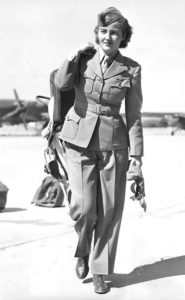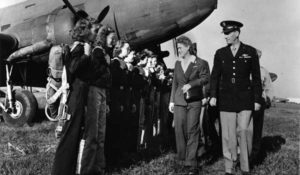
Commander Nancy Harkness Love (1914 – 1976) carries her helmet, goggles, and parachute as she walks across the tarmac of an unidentified airfield in England, September 1942. Photo by PhotoQuest/Getty Images.
I have always been fascinated with the role of women in WWII, particularly the small minority of women whom flew in the Air Transport Auxiliary in Great Britain. However, until very recently I had never heard of the Women Airforce Service Pilots, or WASP as they were known as, who flew planes across the continental United States between 1942 and 1944.
These women were a select group, some of whom had previous flying experience, like their Commander, Nancy Harkness Love, whose job was to ferry planes to and from military bases. Over 25,000 women from across America applied for the WASP program, and only 1,074 women graduated with their ‘wings’ because of the selectiveness of the program. They flew many types of military airplanes, including the large B-51 and B-52 bombers. The WASPs also learnt how to shoot, clean and load ammunition in various weapons, as it was felt that in the case of another war these women could perhaps be used in combat roles.
Essentially, these women were classified as civilians and as such did not classify for military drill or military uniforms. The downside of this classification being that when they left the WASPs in 1945, they didn’t classify for military pensions or medals, though the WASPs certainly deserved medals because of the rigorous training that they went through to graduate from the WASPS program. They had to learn to navigate without a radar system, using string and astronomical and weather charts. The WASPS also had to learn how to land, take-off and maneuver aircraft in all kinds of weather and terrain, as the military bases across the U.S were situated on varying types of terrain.

Jacqueline Cochran, Director of Women Pilots, AAF; and Brig. General Stearley review WASPs of the target-towing squadron at Camp Davis, NC. PhotoQuest/Getty Images.
One WASP, Margaret Phelan Taylor, was just 19 when she joined the WASP program in 1943, she was ¬Ω inch shorter than the regulation 5’2″ required for WASP pilots. However, this did not deter Margaret:¬†‚ÄòWell, there was a lot of short ones just like me, and we laughed at how we got in. [‚Ķ] I just stood on my tiptoes‚Äô.
Being a WASP was a dangerous job, and 38¬†women lost their lives through the short lived two-year WASP program. In 1944, without warning the WASP program was all but disbanded and women told to find their way home. One WASP, Lillian Yonally, remembers when they were dismissed there was no ceremony:¬†‚ÄòNot a darn thing. It was told to us that we would be leaving the base. And we hopped airplanes to get back home’.
After WWII, the WASPs were forgotten about to such an extent that the U.S. Air Force dubbed its opening up of pilot roles to women 1976 stated that it was the first time American women could fly for their country. This started a whole campaign by former WASPs, and their supporters, to finally gain veteran status, which happened in 1976. Subsequently, from this date forward WASPs have gained better recognition and attend Veterans’ events and rallies. Additionally, because these women have finally been recognized they have become an inspiration to young women working in both civilian and military aviation. Women have joined the U.S. Air Force because of the WASPs and their pioneering role in aviation history. Even if you are not interested in aviation, these women are an inspiration to all women to pursue a career and passion that you are truly devoted to.
To learn more, listen to Dr. Katherine Sharp Landdeck’s 2-part podcast on the WASPs. (Part 1) (Part 2)
-Rachel Sayers
Junior Girl
Girl Museum Inc.
